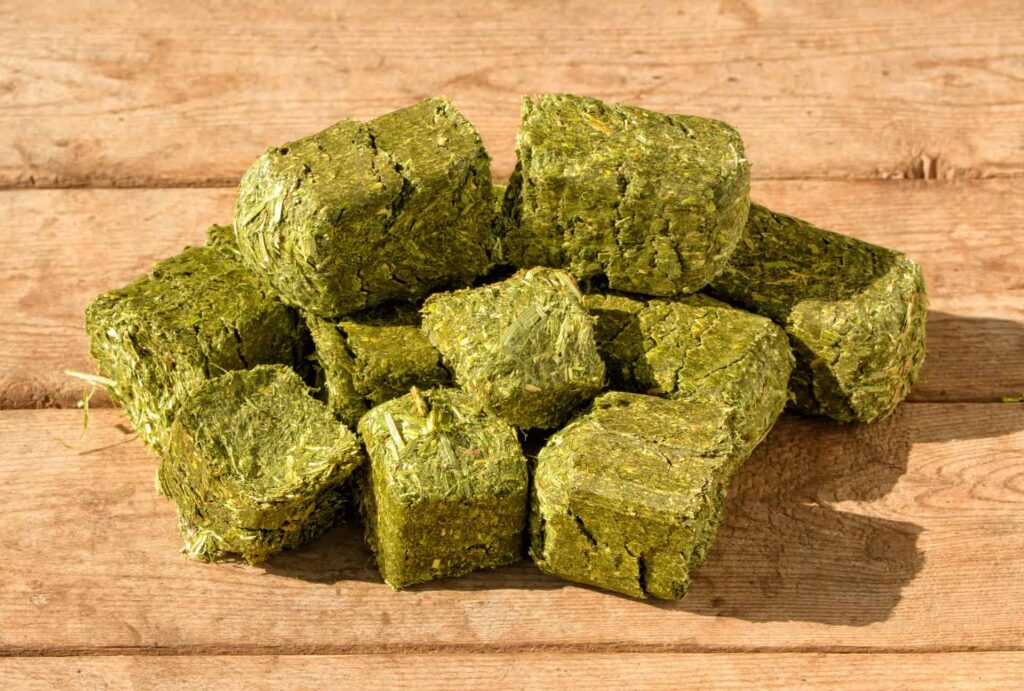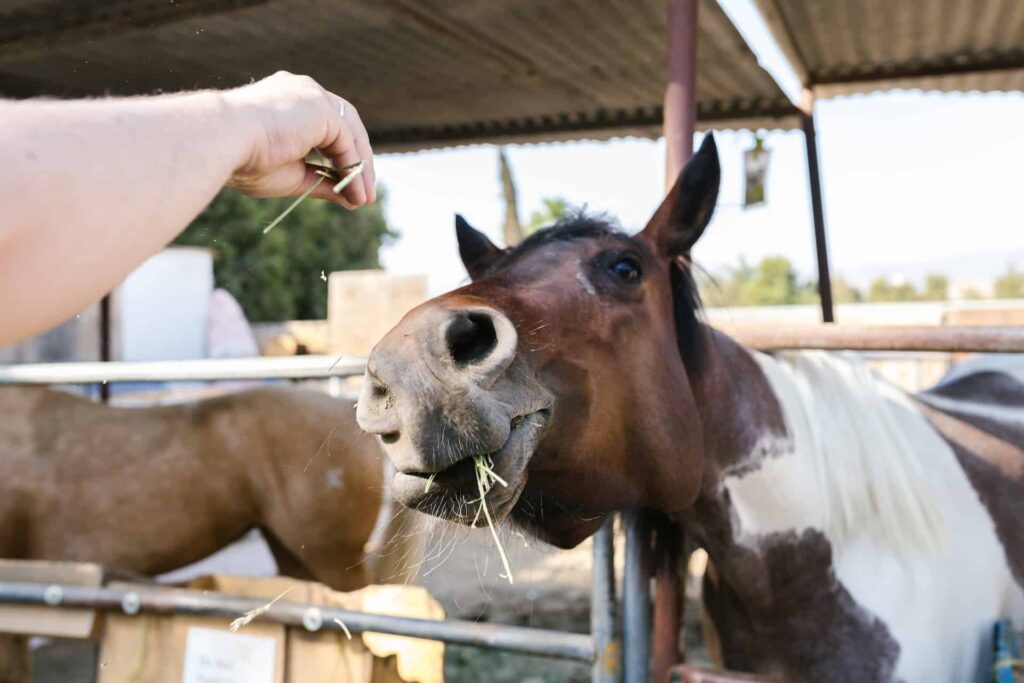Alfalfa is a popular feed choice for horse owners due to its high nutritional value and palatability. When it comes to choosing between alfalfa cubes and pellets, many horse owners debate which one is better suited for their horses. Both alfalfa cubes and pellets are derived from alfalfa hay, but they undergo different processing methods, which give them distinct characteristics and features.
Understanding the differences between alfalfa cubes and pellets is crucial for ensuring the optimal nutrition and well-being of horses. Therefore, it is essential for horse owners to learn about the nutritional values, feeding methods, storage convenience, and cost implications of both alfalfa cubes and pellets before making an informed decision on which one to choose for their horses.
Key Takeaways
- Alfalfa cubes and pellets provide similar nutritional value but differ in processing methods.
- Feeding preferences and storage convenience play a significant role in the choice of alfalfa cubes or pellets.
- Consideration of cost and overall suitability is essential for making an informed decision on the best alfalfa product for horses.
Understanding Alfalfa: Cubes and Pellets
Alfalfa is a widely popular and nutritious forage option for horses. It comes in various forms, including hay, cubes, and pellets. Understanding the differences and benefits of cubes and pellets can help horse owners make the best decision for their animals.
Alfalfa cubes are made by cutting dried hay into smaller pieces, usually one to two inches in length, and mixing it with water and a natural binder like bentonite. The mixture is compressed under high pressure to form cubes, which are then dried for storage. These cubes encourage a horse’s natural grazing behavior more closely than pellets due to their larger size and similarity to hay. The long-stem fiber present in alfalfa cubes promotes healthier digestion and reduces the risk of choking and colic, which can be associated with finer-cut forms of forage like pellets and grain.
On the other hand, alfalfa pellets are produced by grinding the hay into a fine powder and then compressing it into small cylindrical shapes. These pellets can be easily mixed with other feed components such as oil and grain, making them a convenient option for horse owners looking to balance their horse’s daily ration. However, as pellets have shorter fibers, they might not provide all the same digestive benefits as cubes. It is essential to consult with a veterinarian before making any significant changes to your horse’s diet.
Another factor to consider is the storage and handling of alfalfa products. Both cubes and pellets are less prone to mold and dust compared to hay, making them a more suitable option for horses with respiratory issues. They are also space-efficient when compared to storing hay, as they are denser and take up less room. However, alfalfa cubes might require soaking before feeding, especially for older horses or animals with dental issues, to prevent choking hazards.
In terms of nutritional composition, alfalfa cubes and pellets are relatively similar. They both offer essential nutrients like protein, calcium, and various vitamins. However, due to the processing methods, there could be some variations in nutritional content. It’s crucial to analyze and balance the full diet according to the horse’s needs.
In conclusion, alfalfa cubes and pellets both serve as valuable forage alternatives. While cubes are better suited for maintaining natural grazing behavior and providing long-stem fiber, pellets have the advantage of being easily combined with other feed components and offering storage convenience. The choice ultimately depends on the individual horse’s needs and preferences, as well as guidance from a veterinarian.
Nutritional Values of Alfalfa Cubes and Pellets
Alfalfa cubes and pellets are both made from dried, ground alfalfa and provide a concentrated source of nutrients for horses. They are a popular choice for equine nutrition due to their consistent nutrient content and ease of feeding.
The major nutrients found in both alfalfa cubes and pellets include protein, calories, and fiber. Alfalfa is a high-quality protein source for horses, containing essential amino acids that are required for muscle development, maintenance of body weight, and overall health. Crude protein content in alfalfa products usually ranges between 15% to 20%, depending on the maturity of the plant at the time of harvest.
Calories are also an important consideration in equine nutrition, as they provide the energy needed for a horse’s daily activities and growth. Both alfalfa cubes and pellets are good sources of calories, with the average energy value of alfalfa products being 2 Mega-calories (Mcal) per kilogram of dry matter. This energy is primarily derived from the carbohydrates and fats found in alfalfa.
Fiber is another essential component of a horse’s diet and plays a crucial role in maintaining the digestive system’s health. Alfalfa cubes and pellets are rich in fiber, which helps to support normal gut function and promote proper digestion. The fiber content in alfalfa cubes and pellets usually ranges from 25% to 32%, depending on the processing method.
Though both alfalfa cubes and pellets are similar in nutrient content, there may be slight differences in their nutrient profile due to processing. Alfalfa cubes are created by compressing chopped alfalfa hay, which helps to preserve more of the original long-stem fiber structure. On the other hand, alfalfa pellets are finely ground and compressed, which may lead to a slightly higher nutrient density as compared to cubes.
In conclusion, alfalfa cubes and pellets offer a valuable and consistent source of nutrition for horses, with a balanced nutrient profile that includes protein, calories, and fiber. Both options can be a beneficial addition to a horse’s diet to fulfill their nutritional requirements and support overall health. Remember to always consult with a veterinarian or equine nutritionist to determine the best feeding program for your specific horse.
Feeding Horses with Alfalfa Cubes vs Pellets
Benefits of Cubes and Pellets
Alfalfa cubes and pellets are popular options for horse owners when it comes to providing supplemental nutrition or replacing traditional hay in their horses’ diets. The uniform size and shape of pellets make them easy to measure and mix with other types of horse feed, allowing for accurate portion control. This ensures that your horse receives the appropriate amount of nutrients in their diet. On the other hand, alfalfa cubes can be broken down into smaller pieces when soaked, making them easy to consume and digest for horses.
Both options contribute to a horse’s overall health by providing a source of fiber, which aids in digestive function and helps prevent issues like colic. Additionally, these concentrated forms of alfalfa can benefit senior horses and those with dental issues, since they are often easier to chew and digest compared to traditional hay.
Meanwhile, performance horses and racehorses can also benefit from alfalfa products since these are an excellent source of protein and help support muscle development and growth. Furthermore, these substances contribute to increased water intake when dampened, which may help prevent gastric ulcers.
Potential Risks and Considerations
While alfalfa cubes and pellets offer a variety of benefits, there are some potential risks and considerations that horse owners should be aware of. One concern is the possibility of choking, particularly in cases where alfalfa cubes are not adequately soaked before feeding. To mitigate this risk, it’s essential to soak the cubes until they disintegrate into smaller, manageable pieces.
Another potential issue is proper weight management for easy keepers. In some cases, alfalfa cubes and pellets can lead to weight gain in horses that tend to become overweight easily. For such horses, using a ration balancer alongside alfalfa can help maintain a balanced diet and avoid excessive weight gain.
Finally, it is important to note that alfalfa cubes and pellets may not be the ideal solution for every horse. Horses with certain health conditions, such as colic or digestive upsets, might require unique dietary adjustments. Owners should consult with their veterinarian or an equine nutritionist to address specific concerns and create a customized feeding plan tailored to their horse’s specific needs.
Storage and Convenience
Alfalfa cubes and pellets are both convenient options for horse owners when it comes to storage, transportation, and feeding. However, each has its own set of advantages and trade-offs.
In terms of storage space, alfalfa cubes tend to be larger and bulkier than alfalfa pellets, but they are less dense and prone to breaking apart. This means that while they may take up more space in your storage area, they are less likely to generate large amounts of dust compared to pellets. Pellets, being smaller and denser, require less space, making them a popular choice for those with limited storage options or for transport. However, their compact nature makes them more susceptible to producing dust, which can be an issue for some horse owners, especially those with horses that have respiratory issues.
Transportation of alfalfa cubes and pellets is generally easier than hauling traditional hay bales or grass hay due to their compact size and packaging. Both options come in bagged or bulk form, which simplifies the loading and unloading process. In addition, their uniform size makes it easier to measure and mix with other types of horse feed for accurate portion control.
When it comes to weather exposure, alfalfa cubes and pellets are less likely to be affected by moisture compared to hay bales. Both forms can be dampened to increase palatability and contribute to water intake according to Kentucky Equine Research. However, it is important to store them in a dry area with proper ventilation to prevent mold growth and maintain quality.
In terms of convenience, both cubes and pellets can be easily incorporated into a horse’s diet, replacing some or all of the traditional grass hay or chaff. Horse owners benefit from the consistency of pellets and cubes, which tend to have fewer variations between bags than typical hay cuttings. Although alfalfa cubes require additional preparation, such as soaking for a few hours prior to feeding, they offer long-stem forage benefits, which can be important for a horse’s overall health.
In summary, both alfalfa cubes and pellets offer advantages in terms of storage and convenience for horse owners. Each option has its own set of trade-offs, and the best choice depends on factors such as dust sensitivity, storage space, preparation time, and the specific needs of the horse.
Cost and Overall Review
Alfalfa cubes and pellets are both valuable feed options for horses, each offering unique benefits and disadvantages. From a cost perspective, the price of both alfalfa cubes and pellets can fluctuate depending on regional factors and the general availability of alfalfa. However, prices tend to be relatively similar for both types of feed, making the choice between the two often dependent on other factors.
One key advantage of alfalfa pellets is their uniform size and shape, which makes measuring and mixing with other horse feeds easy and accurate. This helps ensure that horses receive the appropriate amount of nutrients in their diet. Pellets also provide a highly digestible energy source and have minimal sugar and starch levels compared to grasshays. On the other hand, some horse owners find alfalfa pellets to be less effective in fulfilling the animal’s need for long-stem forage, which can be an essential part of maintaining a horse’s gastrointestinal health.
Alfalfa cubes, on the other hand, consist of dried hay cut into small pieces and mixed with a binder before being formed into a cube using pressure. They offer more long-stem forage for the horse, which some veterinary professionals may see as a more beneficial option compared to pellets. However, alfalfa cubes require additional preparation, such as soaking for two to three hours before feeding, which can be seen as a disadvantage.
In terms of customer reviews, horse owners tend to have varying preferences, which depend on factors like their horse’s specific nutritional needs and individual experiences with different types of alfalfa feed. It is essential for horse owners to consult with a veterinary nutritionist to make the best choice for their horse’s requirements.
In conclusion, while both alfalfa cubes and pellets offer advantages and disadvantages, the choice between them often comes down to personal preference, taking into consideration the horse’s specific nutritional needs and ease of preparation. It is crucial to consult a professional to make an informed decision on the best feed option for each horse.
Related: Horse Nutrition
Frequently Asked Questions
What are the nutritional differences between alfalfa cubes and pellets?
There are minimal nutritional differences between alfalfa cubes and pellets, as they are both processed forms of alfalfa hay. Their nutritional content depends on the quality of the alfalfa used and the manufacturing process. Pellets are smaller and more uniform in size than cubes, which makes them easier to measure and mix with other horse feed.
How does the cost of alfalfa cubes compare to pellets?
The cost of alfalfa cubes and pellets can vary based on factors such as quality and local availability. Generally, the price difference between the two is not significant. It’s essential to consider factors like ease of use, storage, and preference when choosing between cubes and pellets.
Which is easier for horses to digest: cubes or pellets?
Both alfalfa cubes and pellets can be easily digested by horses. Pellets can be dampened to increase palatability and contribute to water intake. For older horses or those with dental issues, soaking cubes or pellets can further aid in digestion.
Are there specific benefits to feeding cubes instead of pellets?
The main advantage of feeding alfalfa cubes is that they provide a long-stem fiber source, which is important for a horse’s digestive system. Long-stem fiber, defined as hay or grass pasture that is 2″ in length or longer, helps prevent digestive issues.
How much should be fed to optimize the benefits of cubes vs pellets?
The amount of alfalfa cubes or pellets to feed your horse would depend on factors such as the horse’s weight, activity level, and other feed sources. Consult an equine nutritionist or veterinarian to determine the optimal amount for your horse. Remember, it is essential to provide a mix of long-stem fiber sources and not rely solely on cubes or pellets.
Can alfalfa pellets be a substitute for grain in a horse’s diet?
Alfalfa pellets can be used as a partial substitute for grain in a horse’s diet, especially when additional protein and calcium are needed. However, it’s essential to maintain a balanced diet by providing other sources of nutrients, vitamins, and minerals as needed. Consult with an equine nutritionist or veterinarian to create a balanced diet plan for your horse.
Last Updated on September 27, 2023 by Nate Dewsbury



